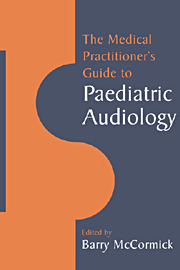Book contents
- Frontmatter
- Contents
- List of contributors
- Preface
- Acknowledgement
- 1 Introduction to hearing problems in childhood
- 2 Causes of deafness
- 3 Behavioural tests
- 4 Pure tone audiometry
- 5 Objective hearing tests
- 6 Middle-ear measurements
- 7 The management of otitis media with effusion
- 8 Management of unilateral hearing loss
- 9 Management of sensorineural hearing loss
- 10 Cochlear implants
- Index
1 - Introduction to hearing problems in childhood
Published online by Cambridge University Press: 01 October 2009
- Frontmatter
- Contents
- List of contributors
- Preface
- Acknowledgement
- 1 Introduction to hearing problems in childhood
- 2 Causes of deafness
- 3 Behavioural tests
- 4 Pure tone audiometry
- 5 Objective hearing tests
- 6 Middle-ear measurements
- 7 The management of otitis media with effusion
- 8 Management of unilateral hearing loss
- 9 Management of sensorineural hearing loss
- 10 Cochlear implants
- Index
Summary
Severe and profound hearing impairment is rare, affecting only one to two babies per thousand births. In nearly 50% of the cases no definite cause of deafness can be found but it is known that those born in special care units are ten times more likely to be affected than their well baby counterparts. Davis and Wood (1992) demonstrated in a group of 2000 babies in the UK that 70% of the hearing impaired from special care units had additional disabilities.
By the age of 3 years, 9% of the deaf population will acquire sensorineural or mixed losses and this proportion rises, eventually to 20%, in later childhood years. Many of these acquired losses will be profound or total in nature with meningitis being the single most common cause. Although this represents a small proportion of all hearing-impaired children it is a very significant group demanding diagnostic and rehabilitation resources and some may become candidates for cochlear implantation.
Another group requiring considerable resources is deaf children with additional disability and special care unit babies are nine times more likely to have dual or multiple disability. Of such cases from special care units, 43% have mixed (conductive and sensorineural) losses in early childhood and this is a much higher proportion than the 10% with mixed losses in the rest of the population.
- Type
- Chapter
- Information
- Publisher: Cambridge University PressPrint publication year: 1995



